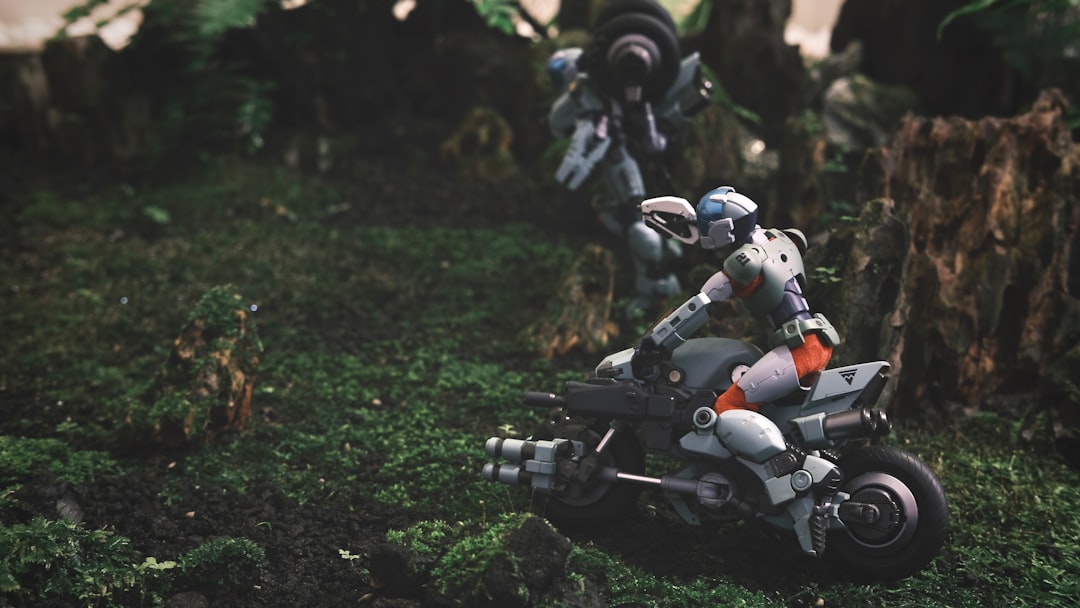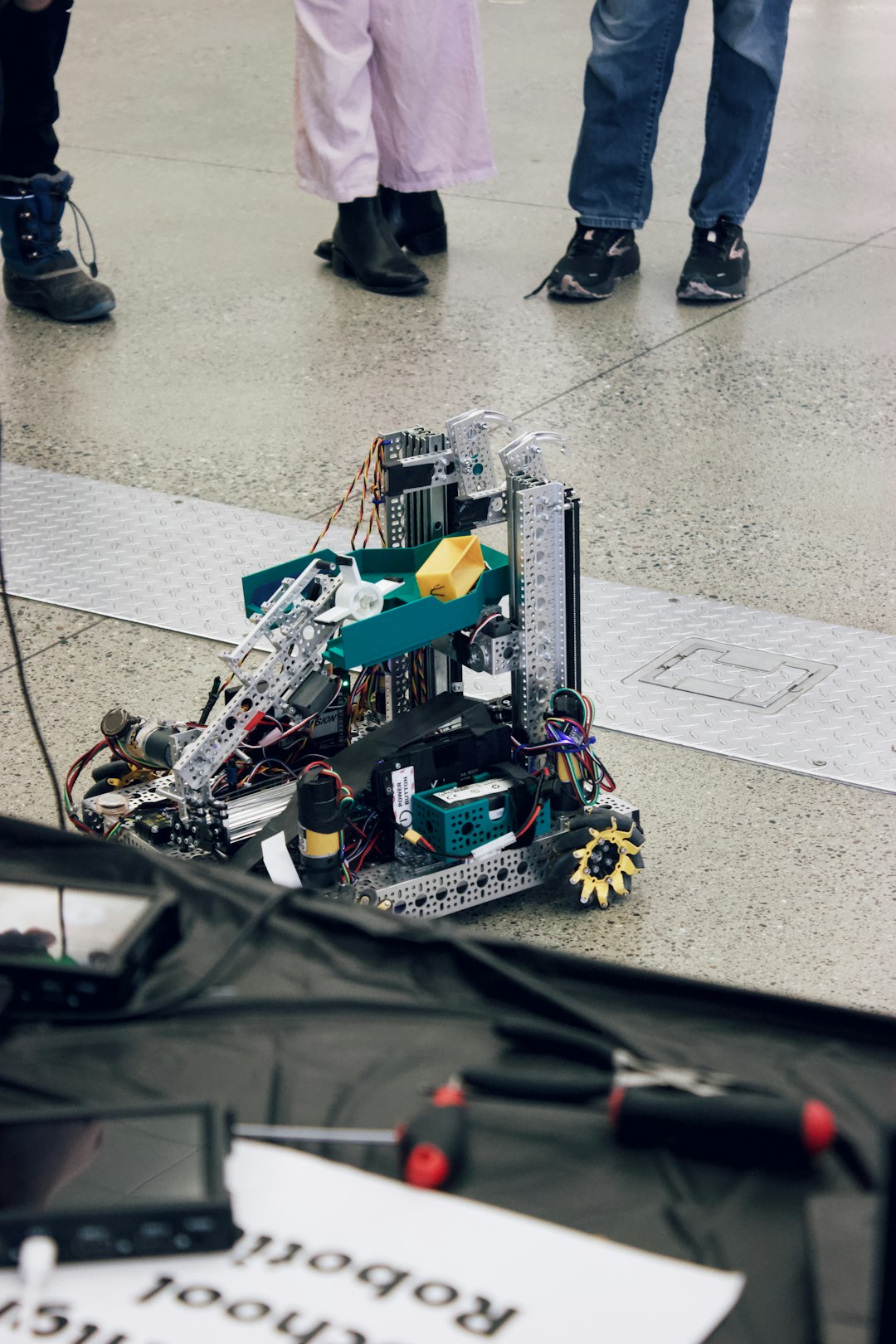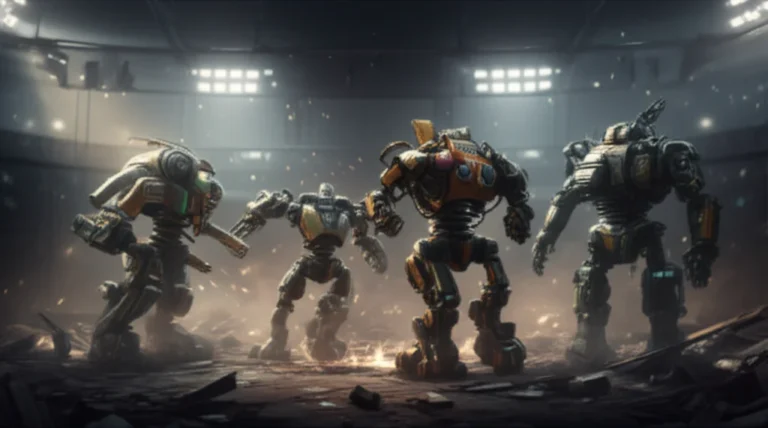Support our educational content for free when you buy through links on our site. Learn more
Inside the Robot Fighting Community: 25 Must-Know Teams & Tips (2025) 🤖

Step into the electrifying world of the robot fighting community, where sparks fly, metal clashes, and friendships are forged in the heat of battle. Whether you’re a curious newcomer or a seasoned builder, this article peels back the curtain on everything you need to know—from the grassroots origins of the sport to the cutting-edge tech shaping its future. Did you know that some of the most successful teams started with humble 1lb bots built in their garages? Later, we’ll reveal the top 25 teams dominating the arenas today and share insider tips on building, upgrading, and funding your own mechanical gladiator.
Curious about how AI and VR might soon revolutionize robot combat? Or wondering where to find your local club and the best online resources? We’ve got you covered. By the end, you’ll not only understand the community’s vibrant ecosystem but also be ready to jump in and start building your own bot with confidence.
Key Takeaways
- The robot fighting community thrives on collaboration, innovation, and inclusivity, welcoming builders of all skill levels and backgrounds.
- Start small and build up: Antweight and Beetleweight classes are perfect for beginners to learn the ropes affordably.
- Top leagues like BattleBots and NHRL offer diverse competition levels and opportunities to grow your skills.
- Access to maker spaces, online forums, and YouTube channels provides invaluable resources for design, fabrication, and strategy.
- Safety is paramount: Strict rules and regulations protect builders and spectators alike.
- Emerging technologies like AI and VR piloting are poised to transform the sport in the near future.
- Funding your bot is easier than you think with sponsorships, crowdfunding, and merch sales.
Ready to start building or upgrade your bot? Check out top-rated kits and parts from trusted suppliers:
- FingerTech Robotics Kits & Parts: Amazon | FingerTech Official
- Brushless Motors & ESCs by Repeat Robotics: Repeat Robotics Official
- Radio Controllers (FrSky, Radiomaster): Amazon FrSky | Amazon Radiomaster
Table of Contents
- ⚡️ Quick Tips and Facts
- 🤖 From Garage Gladiators to Global Arenas: A Brief History of Robot Combat
- 🏟️ Inside the Robot Fighting Community Ecosystem
- 🛠️ Building Your First Combat Bot: A Step-by-Step Journey
- 🔧 15 Proven Upgrades to Make Your Bot a Nightmare in the Arena
- 🎖️ Top 25 Robot Fighting Teams You Should Know
- 🤝 How to Find Local Clubs & Events Near You
- 🎓 Learning Resources: From YouTube to University Courses
- 💰 Sponsorship & Funding Hacks
- 🛡️ Safety First: Rules, Regulations & Insurance
- 🌈 Diversity & Inclusion in the Robot Fighting Community
- 🚀 The Future of Robot Combat: AI, VR & Beyond
- Conclusion
- Recommended Links
- FAQ
- Reference Links
Here is the main body of the article, crafted by the expert team at Robot Fighting™.
Welcome, future champion! You’ve stumbled into the best corner of the internet, the digital garage of Robot Fighting™, where the smell of solder and the sound of grinding metal is our daily bread. We’re a motley crew of designers, engineers, and die-hard fans who live and breathe this sport. We’ve seen it all, from garage-built gremlins to heavyweight titans, and we’re here to pull back the curtain on the single greatest aspect of this hobby: the robot fighting community. This isn’t just about robot fighting; it’s about the people, the passion, and the glorious, organized chaos that brings us all together.
So, grab your safety glasses, and let’s dive into the nuts and bolts of the community that makes this sport tick.
⚡️ Quick Tips and Facts
Before we get into the nitty-gritty, here’s a high-level overview. Think of this as the pre-flight checklist before you launch your bot-building journey.
| Factoid | The Lowdown |
|---|---|
| Community Vibe | Incredibly collaborative. As Make: Magazine puts it, “In all my years, I’ve never encountered a hobby or a sport that has such wonderful people.” Competitors regularly share parts and help fix rival bots before a match. ✅ |
| Getting Started | Start small! This is the #1 piece of advice from veterans like Bunny Sauriol and Jon Bennett. A 1lb “Antweight” or 3lb “Beetleweight” is far more manageable and affordable than a 250lb heavyweight. |
| Key Hubs | The community lives online. The central hub is the Robot Combat Facebook Group, but you’ll also find thriving communities on Reddit’s r/battlebots and the NHRL Discord server. |
| Cost to Enter | You don’t need a second mortgage. A competitive Antweight kit can be built for the price of a nice dinner for two. You can always scale up later. 💰 |
| Safety is Paramount | This isn’t a toy demolition derby. The energy in these weapons is serious. Every event has strict safety rules, and every builder respects them. The SPARC Ruleset is a great place to start learning. |
Quick Tips for Newcomers:
- Go to an event first. Before you buy a single screw, find a local event on RobotCombat.com and just watch. Talk to builders in the pits. You’ll learn more in one afternoon than in a month of online research.
- Buy a kit for your first bot. Don’t try to design a world-beater from scratch. Kits like the FingerTech ‘Viper’ are proven designs that teach you the fundamentals of building and driving.
- Ask questions! The community is your greatest resource. No question is too dumb. Post on the forums, ask on Discord, and chat with people. We were all beginners once.
🤖 From Garage Gladiators to Global Arenas: A Brief History of Robot Combat

Ever wonder how this magnificent sport of mechanical mayhem got started? It wasn’t born in a sterile lab. It was forged in the fiery crucible of creativity and counter-culture. The story begins in the 90s, with two parallel universes of robotic destruction: Robot Wars in the UK and BattleBots in the US.
These shows weren’t just TV; they were a cultural phenomenon. They took the niche hobby of a few San Francisco artists and engineers, like the legendary Mark Pauline of Survival Research Laboratories, and blasted it into living rooms worldwide. Suddenly, names like Razer, Hypno-Disc, Vlad the Impaler, and BioHazard became household names. They were the rock stars, and their stage was a polycarbonate box.
When the big TV shows went off the air in the early 2000s, did the sport die? ❌ Absolutely not.
This is where the community truly showed its strength. The passion didn’t fade; it went underground. Builders kept building. They organized smaller, local events in warehouses, school gyms, and convention halls. This “grassroots era” is what built the foundation for the sport we know today. It fostered the collaborative spirit and created organizations like the Robot Fighting League (RFL) that standardized rules and weight classes, paving the way for the sport’s explosive return to television and the rise of incredible leagues like the Norwalk Havoc Robot League (NHRL).
🏟️ Inside the Robot Fighting Community Ecosystem
The robot fighting community isn’t just one thing; it’s a sprawling, interconnected ecosystem of leagues, workshops, and digital hangouts. Here’s how to navigate it.
🌐 Global Leagues & Circuits
This is where the titans clash. Each league has its own flavor and focus.
- BattleBots: The big one. The heavyweight championship you see on the Discovery Channel. It’s the pinnacle of the sport in terms of budget, production value, and sheer destructive power. Getting here is the dream for many builders.
- Norwalk Havoc Robot League (NHRL): The rising star and the heart of the grassroots-to-pro pipeline. NHRL focuses on smaller weight classes (3lb, 12lb, 30lb) and hosts monthly events with incredible production quality, streamed for free on their YouTube channel. It’s arguably the best place to see the most diverse and innovative designs in action.
- RoboGames: Known as the “Olympics of Robot Combat,” this event features dozens of different weight classes and even other robotic sports. It’s a massive celebration of all things robotics.
- Fighting Robots Association (FRA): The governing body for robot combat in the UK. If you’re across the pond, this is your starting point for finding events and connecting with the vibrant British scene.
🛠️ Maker Spaces, Hackerspaces & Fab Labs
Where do you build a robot if you don’t have a garage full of industrial machinery? You find your local maker space! These shared workshops are community centers for builders. They provide access to essential, and often expensive, tools like:
- 3D Printers: For making custom parts, armor, and prototypes.
- CNC Mills & Lathes: For precision-machining metal components.
- Laser Cutters: For cutting plastic and wood armor panels.
- Welding Equipment: For joining frame components.
More importantly, they are full of knowledgeable people who can help you learn to use this equipment. You can find a space near you through directories like the Hackerspaces.org Wiki and FabLabs.io.
📺 Media Channels & Streaming Platforms
The community thrives on sharing. As the RobotCombatWiki page on the community shows, there’s a vast network of content creators.
- YouTube: This is the primary video hub. You’ll find:
- Official Event Coverage: BattleBots and NHRL post full fights and highlights.
- Team Channels: Get behind-the-scenes looks at design, building, and testing from teams like Team Whyachi, Jamison Go, and Robert Cowan.
- Tutorials & Explainers: Channels dedicated to teaching you the ropes of robot building.
- Discord & Facebook: These are the digital pits. The NHRL Discord and the main Robot Combat Facebook Group are where builders chat in real-time, troubleshoot problems, and share the latest memes.
- Reddit: The r/battlebots subreddit is the main forum for fans to discuss the show, speculate on matchups, and interact directly with builders.
🛠️ Building Your First Combat Bot: A Step-by-Step Journey
Alright, you’re inspired. You’re ready to make sparks fly. But how do you go from zero to a functioning robot? It’s a journey, not a sprint. We’ve broken it down into four key phases, echoing the advice often seen in builder forums.
Phase 1: Concept & Weight-Class Matchmaking
This is the daydreaming phase, but with constraints.
- Choose Your Weight Class: We can’t say it enough: start small. A 1lb Antweight or 150g Fairyweight is perfect. The parts are cheaper, the physics are more forgiving, and you can build it on your kitchen table. You’ll learn all the same lessons without the five-figure budget.
- Pick an Archetype: What’s your fighting style?
- Vertical Spinner: A spinning bar or disc that hits upwards. Think End Game or Bite Force.
- Horizontal Spinner: A spinning bar or blade that hits sideways. Think Tombstone or Gigabyte.
- Flipper/Lifter: Uses a pneumatic or electric arm to toss or control opponents. Think Bronco or Hydra.
- Crusher/Clamper: Uses a hydraulic or screw-driven jaw to pierce and grip. Think Razer or Kraken.
- Hammer Bot: A powerful overhead hammer or axe. Think Shatter! or Beta.
Your first bot doesn’t need to reinvent the wheel. Pick a simple, effective design. For more ideas, check out our deep dives into Robot Design and Engineering.
Phase 2: CAD, Materials & Sourcing Parts
Time to make it real… on a computer, at least.
- CAD it Up: Use Computer-Aided Design (CAD) software to model your bot. Autodesk Fusion 360 is free for hobbyists and is the community standard. This lets you check for part interference, calculate your center of gravity, and estimate weight before you spend a dime.
- Material Selection: Your material choice depends on your budget and design.
- Chassis: HDPE, UHMW plastic, or Aluminum are great starting points.
- Armor: Polycarbonate is fantastic for seeing inside your bot and taking hits. For more serious armor, builders use Titanium or AR500 steel.
- Sourcing Parts: The community is supported by amazing small businesses that cater specifically to robot combat. These are your go-to suppliers:
- FingerTech Robotics: The king of Antweight and Beetleweight parts.
- Repeat Robotics: Known for their incredible brushless drive motors and ESCs.
- Botkits: A great source for kits and parts in the 1lb to 15lb range.
- HobbyKing: A general hobby store perfect for finding Turnigy motors, LiPo batteries, and radio transmitters.
This is the heart of DIY Robot Building, and it’s where you’ll learn the most.
Phase 3: Final Integration & Cosmetics
This is where your pile of parts becomes a robot. It’s a puzzle of screws, wires, and zip ties.
- Assembly: Follow your CAD model. Be patient. Things will not fit perfectly the first time. This is normal.
- Wiring: This is critical. A loose wire can lose you a match. Keep it clean, secure everything, and protect wires from the spinning weapon!
- The Weigh-In: The moment of truth. Put your fully assembled bot on a scale. Are you under the weight limit? If not, it’s time for “unscheduled rapid weight loss” (i.e., drilling holes in things).
- Cosmetics: Give your bot some personality! A cool paint job, googly eyes, or 3D-printed flair makes it yours. This is what makes the crowd love you.
Phase 4: Advanced AI & Combat Logic
Okay, let’s be real. For 99% of builders, “combat logic” is you, with a transmitter in your hands, heart pounding. Most combat robots are fully remote-controlled.
However, the frontier is pushing towards autonomy. As one user on a RobotShop community forum noted when discussing a complex build, “For truly ‘intelligent’ fighting, a local microcomputer or an offboard machine-learning pipeline that commands the robot in real time” is the future.
This involves:
- Sensors: Using IMUs (like the MPU-6050) to detect hits or orientation.
- Onboard Processing: Using a small computer like a Raspberry Pi to make decisions.
- Code: Programming defensive maneuvers (e.g., “if hit on the left, turn right”) or even autonomous weapon control.
For now, this is an advanced topic for seasoned pros. Master driving first. But know that the future is coming, and it’s smart.
🔧 15 Proven Upgrades to Make Your Bot a Nightmare in the Arena
Ready to level up your game? Once you’ve got a basic bot running, here are 15 upgrades the pros use to gain a competitive edge. These are the secret ingredients for turning a contender into a champion.
- Switch to Brushless Drive: Ditch the brushed motors. Brushless motors (like those from Repeat Robotics) offer way more power, speed, and efficiency for the same weight.
- Use High-Discharge LiPo Batteries: Your motors are only as good as the power you feed them. High “C” rating LiPo batteries from brands like Tattu deliver the current needed for explosive acceleration.
- Implement a Self-Righting Mechanism (SRiMech): Can your bot get back on its feet if flipped? If not, you’re one good hit away from being counted out. A simple arm or even the shape of your chassis can solve this.
- Armor with AR500 Steel: For weapon tips or front armor, this stuff is incredibly tough and abrasion-resistant. It’s what they use for bulletproof targets!
- Upgrade to a Quality Radio Transmitter: A cheap transmitter can lead to signal loss (a “failsafe”). A reliable radio like the FrSky Taranis Q X7 or a Radiomaster Zorro is a worthy investment.
- Use Titanium for Key Structural Parts: It’s lighter than steel but stronger than aluminum. It’s expensive, but using it for weapon shafts or critical frame members can save weight and add durability.
- Incorporate Redundancy: Can your bot still drive if one side of the drive is knocked out? Some designs use four motors instead of two for this very reason.
- Master Your Weapon Gearing: Don’t just slap a motor on a weapon. Use belts or gears to achieve the optimal tip speed. Too slow and you won’t do damage; too fast and you’ll burn out your motor.
- Use Threadlocker on Every Screw: The vibration in a combat robot is intense. A screw that backs out can cause a catastrophic failure. Use Loctite (the blue kind!) on everything.
- Magnetize Your Bot (for steel floors): If the arena floor is steel, adding powerful neodymium magnets to the bottom of your bot can dramatically increase your traction and pushing power.
- Custom-Wound Motors: The ultimate power move. Some top teams rewind their own brushless motors with thicker wire to handle more current and produce insane torque.
- Invest in Shock-Mounting for Electronics: Your receiver and ESC are delicate. Mounting them on foam or soft rubber can protect them from the brutal shock of weapon impacts.
- Use Form-Tapping Screws in Plastic: Instead of using nuts, you can use special screws that form their own threads in plastics like HDPE and Polycarbonate, saving weight and assembly time.
- Design for Serviceability: How quickly can you replace a motor or battery in the pits? A good design can be taken apart and put back together in minutes. This is a match-winning feature.
- Analyze Your Opponents: Watch their past fights. Do they have a weak side? Does their weapon break easily? A good strategy can beat a stronger robot. This is the core of Robot Battle Strategies.
🎖️ Top 25 Robot Fighting Teams You Should Know
The builders are the soul of the sport. Following these teams is a great way to learn and get inspired. Here are 25 teams, from legends to rising stars, that every fan should know.
- Team Whyachi (Whyachi): Legends of the sport, creators of heavyweight spinners Son of Whyachi and Hydra.
- RioBotz (Minotaur): The Brazilian team behind the terrifyingly destructive drum spinner Minotaur. Their book, the RioBotz Combat Robot Tutorial, is considered the bible of robot building.
- Seems Reasonable Robotics (End Game): The New Zealand team that built the dominant vertical spinner End Game, a two-time BattleBots Giant Nut winner.
- Witch Doctor & Shaman (Witch Doctor): Andrea and Mike Gellatly are fan favorites and top contenders with their iconic bot Witch Doctor.
- Paul Ventimiglia (Bite Force): The builder behind the only three-time BattleBots champion, the legendary Bite Force.
- Ray Billings (Tombstone): The master of kinetic energy and builder of the most feared horizontal spinner of all time, Tombstone.
- Orion Beach (SawBlaze): A brilliant engineer and driver, creator of the devastating hammer-saw bot SawBlaze.
- Jamison Go (SawBlaze, Overhaul): A key member of the SawBlaze team and a fantastic content creator who provides deep insights into the engineering.
- Bunny Sauriol (Malice): A pillar of the community and captain of Team Malice, known for her powerful horizontal spinner and for being an incredible ambassador for the sport.
- Ewerton & Daniel Freitas (Whiplash): A father-son duo with an incredibly effective lifter/spinner combination bot, Whiplash.
- Will Bales (Hypershock): Known for his high-energy driving and the beautiful, lightning-fast vertical spinner Hypershock.
- Jake Ewert (Hydra): The driver of the most powerful flipper in the world, Hydra, and a master of strategic driving.
- Matt Vasquez (Whiplash, Skorpios): An incredibly skilled driver and builder, known for his work on Whiplash and the aggressive saw-bot Skorpios.
- Kurtis Wanner (Crash ‘n Burn): A Canadian builder and event organizer who is a cornerstone of the scene up north.
- Jon Bennett (Hypothermia): A BattleBots competitor and the official photographer for BattleBots and NHRL, capturing the sport’s most iconic moments.
- Brandon Young (Big Dill, Mammoth): A prolific builder across multiple weight classes and a mentor at the University of Maryland’s robotics club.
- Lucy Du (HotLeafJuice, SawBlaze): A talented engineer and builder who has worked on top-tier teams like SawBlaze and Overhaul.
- Emmanuel Carrillo (Big Dill, MadCatter): A designer and kit maker who has had a hand in some of the most recognizable bots in the field.
- Alex Hatt (Valkyrie): Captain of the team behind the powerful undercutter Valkyrie and a graduate of MIT.
- Craig Danby (Cobalt, Carbide): A UK builder responsible for some of the most powerful vertical spinners on both sides of the Atlantic.
- Team Shatter! (Shatter!): Innovators who brought the first omni-directional wheels and a powerful hammer to the modern era.
- David Jin (Copperhead): The team behind the compact, brick-like drum spinner Copperhead that hits absurdly hard.
- Team Ribbot (Ribbot): Known for their modular design, allowing them to switch between a horizontal spinner, vertical spinner, and lifter.
- Zack and Aaron Lussier (Monsoon): A UK/US team with a massive and powerful vertical spinner, Monsoon.
- Team HUGE (HUGE): Creators of one of the most unique and effective designs in the sport, the massive-wheeled HUGE.
🤝 How to Find Local Clubs & Events Near You
Watching on TV is one thing. Feeling the thud of a 30lb bot hitting the wall is another. Here’s your action plan for finding the community in the real world.
- Step 1: Check the Event Calendars. The two best places to start are the RobotCombat.com Events Page and the BuildersDB Events List. These are comprehensive lists of events across North America and beyond.
- Step 2: Search on Facebook. This is where the local communities live. Search for
"[Your State/City/Region] Robot Combat"or"[Your Country] Robot Combat". You’ll find groups like the NorthEast Robotics Club (NERC) or Melbourne Combat Robotics. - Step 3: Visit the League Websites. Major leagues like NHRL have their own event schedules. If you’re near Norwalk, CT, you can attend an event almost every month!
- Step 4: Just Show Up! As Brandon Young advised in Make: Magazine, the best first step is to “attend local events to learn and start with smaller weight classes.” Go as a spectator. Walk the pits (if allowed), talk to the builders between matches, and soak it all in. You’ll be welcomed with open arms.
🎓 Learning Resources: From YouTube to University Courses
The robot combat community is built on open-source knowledge. Here are the best places to level up your skills.
Online Communities & Forums
- Robot Combat Wiki: The encyclopedia of the sport. If you have a question about a bot, a part, or a rule, the answer is probably here.
- Facebook Groups: The main Robot Combat group is for general discussion. For specific questions, join the weight-class groups like Antweights or Featherweights.
- The FRA Forum: A classic, long-running forum with a wealth of knowledge, particularly from the UK scene.
Essential Reading
- The RioBotz Combat Robot Tutorial: Free to download and considered the single most important text for learning the engineering principles behind building a competitive robot.
- Ask Aaron: A Q&A blog by veteran builder Aaron Hill that answers hundreds of common (and not-so-common) builder questions.
YouTube University
- Event Channels: NHRL and BattleBots for fight footage.
- Builder Channels: Robert Cowan for amazing tutorials on everything from CAD to electronics. Jamison Go for deep engineering dives. Team Just ‘Cuz Robotics for fantastic build reports.
Formal Education
Many top builders are engineers who honed their skills in university. Look for schools with strong Mechatronics, Mechanical, or Electrical Engineering programs. Even better, join a university’s robotics club or a competitive team like a Formula SAE or Baja SAE team. The skills in design, fabrication, and teamwork are directly transferable.
💰 Sponsorship & Funding Hacks
Let’s talk money. This hobby can get expensive, especially as you move up in weight class. But you don’t have to fund it all yourself. Here’s how to get sponsors on board.
- Create a Professional Proposal: Don’t just send an email saying “please give me money.” Create a one-page PDF that includes:
- Your team name and logo.
- A short bio.
- Renderings or photos of your robot.
- A clear explanation of what you need (e.g., “sponsorship to cover the cost of raw materials” or “in-kind sponsorship of 10 brushless motors”).
- What you offer in return: This is key! Offer logo placement on the bot, social media shoutouts, and mentions in interviews.
- Target Relevant Companies: Who benefits from being associated with robotics and engineering?
- Material Suppliers: Metal distributors (SendCutSend is a huge community sponsor), plastics companies.
- Hardware & Electronics Companies: Manufacturers of motors, ESCs, batteries.
- Local Machine Shops: Offer to put their logo on your bot in exchange for some free or discounted machining time.
- Sell Merch: If you have a cool bot and a good following, sell t-shirts, stickers, and enamel pins. It’s a great way for fans to support you directly.
- Patreon & Crowdfunding: For established teams with a following, platforms like Patreon can provide a steady stream of income from your biggest fans in exchange for exclusive content.
🛡️ Safety First: Rules, Regulations & Insurance
We love glorious destruction, but we love having all our fingers and toes even more. Safety is the most important rule in robot combat. The energy stored in a heavyweight’s spinning weapon is comparable to a high-powered rifle. This is not a game.
Key Safety Rules
- The Arena (“The Box”): Fights happen inside a sealed arena, typically made of thick, bullet-resistant polycarbonate, to contain flying parts.
- Weapon Locks: Every robot must have a clearly visible and sturdy physical lock that prevents the weapon from moving or spinning in the pits.
- Power & Failsafes: Robots must have a master power switch that is easily accessible. Radio systems must be configured with a “failsafe,” so if the signal is lost, the robot’s drive and weapon systems shut down immediately.
- Activation: Robots are only activated inside the arena, just before a match, under the supervision of event staff.
Most non-televised events in North America follow the SPARC (Standardized Procedures for an Advancing Robotic Combat) Ruleset. Reading and understanding this document is a non-negotiable first step. For a full breakdown, visit our section on Robot Combat Rules and Regulations.
🌈 Diversity & Inclusion in the Robot Fighting Community
Is this just a boy’s club? ❌ Not a chance.
One of the best things about the robot fighting community is its welcoming nature. It’s a meritocracy of metal. Nobody cares about your background; they care about your build quality and your driving skill. As Kurtis Wanner told Make: Magazine, “I’ve never encountered a hobby or a sport that has such wonderful people.”
We’re proud to see so many brilliant women leading the charge in this sport. Builders like Andrea Gellatly (Witch Doctor), Bunny Sauriol (Malice), Lucy Du (SawBlaze), and Alex Hatt (Valkyrie) are not just “female builders”; they are some of the best builders in the world, period. They are role models who are inspiring a new generation of engineers, both male and female.
The community is a place for everyone—students, parents, professional engineers, artists, and everyone in between. If you have a passion for creating and a love for competition, you belong here.
🚀 The Future of Robot Combat: AI, VR & Beyond
So, what’s next for our favorite sport? The future is bright and full of terrifying new possibilities.
- The Rise of AI: While most bots are human-controlled, we’re on the cusp of seeing more autonomous functions. Imagine a bot that can automatically track its opponent with its weapon or a spinner that can sense an impending impact and brace itself. The discussions on forums about implementing “reactive blocking” are just the beginning.
- Immersive Piloting: What if you could see from your robot’s point of view? FPV (First-Person View) and even VR (Virtual Reality) piloting could change the game, allowing for driving precision we can only dream of today.
- New Materials & Manufacturing: Advances in 3D printing with materials like carbon fiber-infused nylon and even metal are making complex, lightweight, and incredibly strong designs more accessible than ever before. What new design archetypes will these technologies unlock?
The core of the sport—the community, the creativity, the competition—will always remain. But the technology is constantly evolving, and we can’t wait to see what these brilliant builders come up with next. The question isn’t if a robot will win a match using AI, but when. And we’ll be right here to see it.
Conclusion

Well, there you have it — the full throttle, no-holds-barred insider’s guide to the robot fighting community! From the humble beginnings of garage gladiators to the roaring crowds of global arenas, this community is the beating heart of the sport. It’s a place where passion, creativity, and camaraderie collide in the most spectacular ways.
If you’re itching to build your first bot, remember: start small, learn fast, and lean on the community. The journey from sketching your first design to hearing the crowd roar as your bot smashes the competition is thrilling, challenging, and deeply rewarding. And if you’re dreaming of the future — AI-driven bots, immersive VR piloting, and cutting-edge materials — know that the community will be there to help you push those boundaries.
The community’s spirit of collaboration and inclusivity means you’re never alone in this adventure. Whether you’re a student, a seasoned engineer, or just someone who loves the idea of robots duking it out, there’s a place for you here.
So, what about that question we teased earlier — when will AI-powered bots dominate the arena? The answer is: it’s coming sooner than you think. But until then, the heart and soul of robot combat remain in the hands of passionate builders and drivers just like you.
Ready to join the fray? We’ll see you in the pits!
Recommended Links
Here are some essential products and resources to get you started or upgrade your bot-building toolkit:
-
FingerTech Robotics Viper Kit:
Amazon | FingerTech Official Website -
Repeat Robotics Brushless Motors & ESCs:
Repeat Robotics Official Website -
FrSky Taranis Q X7 Radio Transmitter:
Amazon | FrSky Official Website -
Radiomaster Zorro Radio Controller:
Amazon | Radiomaster Official Website -
Autodesk Fusion 360 (CAD Software):
Autodesk Official Website -
RioBotz Combat Robot Tutorial (Book):
Amazon -
Ask Aaron Robot Combat Q&A:
Ask Aaron Website -
SPARC Ruleset PDF:
SPARC Official Rules
FAQ

What is the Robot Fighting League and how does it work?
The Robot Fighting League (RFL) is a governing body and community organization that oversees robot combat events, primarily in the United States. It sets standardized rules, weight classes, and safety protocols to ensure fair and safe competition. The RFL organizes events where builders bring their robots to compete in various weight classes, ranging from tiny antweights (under 1 lb) to massive heavyweights (up to 250 lbs or more). Competitors remotely control their robots in an enclosed arena, aiming to disable or immobilize their opponents.
The league fosters community growth by supporting local clubs, providing resources for new builders, and promoting the sport through media and events. It’s a great entry point for newcomers and a platform for veterans to showcase their skills.
Read more about “Is There Robot Fighting in Real Life? 🤖 The Ultimate 2025 Guide”
How do I build a robot for the Robot Fighting League?
Building a robot for the RFL involves several key steps:
- Choose a Weight Class: Start with a manageable class like Antweight or Beetleweight to keep costs and complexity down.
- Design Your Bot: Use CAD software like Autodesk Fusion 360 to model your robot, considering weapon type, drive system, and armor.
- Source Parts: Purchase motors, batteries, controllers, and materials from specialized suppliers like FingerTech Robotics or Repeat Robotics.
- Assemble and Test: Build your chassis, install electronics, and test all systems thoroughly.
- Follow RFL Rules: Ensure your robot complies with the league’s safety and construction regulations.
- Practice Driving: Master remote control skills to maximize your bot’s effectiveness in the arena.
For detailed guides, check out our Robot Building Guides and DIY Robot Building sections.
Read more about “How Much Does a BattleBot Weigh? The Ultimate 2025 Guide 🤖⚖️”
What are the rules and regulations of robot fighting competitions?
Robot combat competitions follow strict rules to ensure safety and fairness. Key regulations include:
- Weight Limits: Robots must not exceed the maximum weight for their class.
- Weapon Restrictions: Some weapons (like explosives or liquids) are banned. Most weapons must be electrically or mechanically powered.
- Safety Features: Robots must have weapon locks, master power switches, and fail-safes on radio control systems.
- Arena Requirements: Matches occur inside enclosed arenas with bullet-resistant walls.
- Match Conduct: Robots are activated only inside the arena, and matches have time limits and scoring criteria.
The SPARC Ruleset is the most widely adopted standard in North America. For more, visit our Robot Combat Rules and Regulations page.
Read more about “The Ultimate Robot Fighting Forum Guide: 20 Must-Join Communities 🤖 (2025)”
Can I join the Robot Fighting League as a beginner with no experience?
Absolutely! The RFL and the broader robot fighting community are incredibly welcoming to beginners. Many builders start with small, simple bots and learn through trial, error, and community support. Attending local events as a spectator or volunteer is a great way to get your feet wet. Most leagues encourage newcomers and often have mentorship programs or beginner-friendly competitions.
Read more about “🐜 Ultimate Guide to Antweight Robots: Top 15 Builds & Tips (2025)”
What types of robots are allowed to compete in the Robot Fighting League?
The RFL allows a wide variety of robot designs, including:
- Spinners: Horizontal or vertical spinning weapons.
- Flippers/Lifters: Robots that toss or flip opponents.
- Crushers/Clamps: Robots that grip or crush.
- Hammers: Overhead hammers or axes.
- Hybrid Designs: Combinations of the above.
Robots must comply with safety and weight class rules, but creativity is encouraged. For inspiration, check out our Robot Design and Engineering articles.
Read more about “How Much Do BattleBots Make? 💸 The Shocking Truth (2025)”
How do I register my robot for an upcoming Robot Fighting League event?
Registration typically involves:
- Finding an Event: Check the RobotCombat.com Events Page or your local league’s website.
- Submitting an Entry: Fill out an online registration form with your team and robot details.
- Paying Entry Fees: Fees vary by event and weight class.
- Pre-Event Inspection: Bring your robot for a safety and rules compliance check before the match.
Each event will provide specific instructions. Early registration is recommended as spots can fill quickly.
What are the most common components and materials used to build competitive fighting robots?
Competitive bots commonly use:
- Motors: Brushless DC motors for drive and weapons (e.g., from Repeat Robotics).
- Batteries: High-discharge LiPo packs for power.
- Controllers: Radio transmitters like FrSky Taranis or Radiomaster Zorro; microcontrollers or SBCs (Arduino, Raspberry Pi) for advanced bots.
- Materials: Aluminum and titanium for chassis; polycarbonate and AR500 steel for armor.
- Electronics: ESCs (Electronic Speed Controllers), IMUs for sensing, and fail-safe circuits.
Choosing quality components and materials is crucial for durability and performance. For detailed parts lists and sourcing, see our DIY Robot Building guides.
Reference Links
- Robot Combat Facebook Group — The central hub for community discussion and support.
- RobotCombatWiki – RobotCommunity — Comprehensive directory of forums, groups, and resources.
- FingerTech Robotics — Leading supplier of robot combat kits and parts.
- Repeat Robotics — Specialist in brushless motors and ESCs.
- FrSky Radio Controllers — Popular radio control systems for combat robots.
- Radiomaster RC — Affordable and reliable radio transmitters.
- Autodesk Fusion 360 — Industry-standard CAD software for robot design.
- RioBotz Combat Robot Tutorial — The definitive guide for combat robot engineering.
- Ask Aaron Robot Combat Q&A — Expert answers to common robot combat questions.
- SPARC Ruleset — Standardized rules for safe and fair robot combat.
- Robot Fighting League Official Site — Learn about the league’s history and events.
- NHRL Discord Server — Real-time community chat and support.
Ready to join the ranks of builders and fighters? The arena awaits — and so does the community that will help you conquer it!






